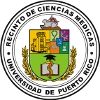The School of Pharmacy of the University of Puerto Rico, originally established as a Department of Pharmacy, and later known as the College of Pharmacy, was founded on September 22, 1913 at the Río Piedras Campus. It was the first program in a health profession to be offered at a higher education level in Puerto Rico, and the first to be accredited. The first twelve pharmacists graduated in 1915 from a two year program. The College was the sole provider of an entry level degree in pharmacy education in Puerto Rico until 2001. It changed its official name to School of Pharmacy in 1989.
In 1925, the Department of Pharmacy was organized as a college of the University of Puerto Rico. In 1928, it began offering a four year pharmacy program leading to the degree of Bachelor of Pharmaceutical Sciences.
In the early thirties, the College moved to a building of its own, named after Dr. Agustín Stahl, an eminent Puerto Rican botanist and scientist. In 1932, it was accepted as a member of the American Association of Colleges of Pharmacy. In 1949, the School began its five year Bachelor of Pharmaceutical Sciences program, being the second school in the nation to adopt such a program, eleven years before it was required for accreditation. The program was first accredited by the American Council on Pharmaceutical Education in 1952, and it has been accredited ever since.
In the 1970s, the Island was rapidly transforming itself from an agricultural society to an industrial one and was already considered the world capital of the pharmaceutical industry. Foreseeing that trend, the College of Pharmacy began offering a pharmaceutical manufacturing course and laboratory since the early sixties. Another school initiative was the Drug Information Center established in 1973, which is still the only one of its kind in Puerto Rico and one of the best resources in Latin America.
As part of our mission, the Continuing Education Division was established in 1979 to provide pharmacists and pharmacy technicians the opportunity of keeping their knowledge and skills up to date in area related with the practice of pharmacy.
The new shift in pharmacy practice and education to clinical pharmacy required the transfer of the College from the Río Piedras Campus to the Medical Sciences Campus (MSC) of the University of Puerto Rico. In 1977, the College was physically transferred to the MSC. The Bachelor in Sciences in Pharmacy program was offered from 1981 to 2003, following a clinically oriented curriculum. In 1984, the Council on Higher Education approved a new administrative organization creating two departments, the Pharmaceutical Sciences Department and the Department of Pharmacy Practice, each directed by a Chairperson. A Master of Science program with options in Industrial Pharmacy and Pharmaceutical Sciences (Medicinal Chemistry) was established in 1988, providing highly trained individuals for the pharmaceutical industry in the Island.
The nineties provided new opportunities for the School of Pharmacy in terms of its research endeavors and service to the community. The natural products field, in tune global resurgence and interest in neutraceuticals and herbal medicine became an area of research. Another major area, industrial pharmacy, provided opportunities for training professionals to respond to the needs of the pharmaceutical industries in the Island. In 1993, a state of the art doping control laboratory, currently known as the Chemical Forensic Laboratory began operations. This laboratory is the first of its kind in Latin America.
Instruction at clinical settings and the strengthening of research capabilities have contributed to the development of the pharmacist’s new roles and to the evolution of pharmaceutical education to the broader concept of pharmaceutical care. In this new role, the pharmacist assumes responsibility of overseeing the effectiveness of the pharmacotherapy. The School of Pharmacy adopted this philosophy with the implementation of the Doctor in Pharmacy Program (Pharm.D.) in 2001. The curriculum focuses on the development of general and professional abilities, the integration of theory and practice, as well as active and collaborative learning.
In 1999 the School inaugurated the Center for Pharmaceutical Processing Research/University of Puerto Rico (CPPR-UPR). The Center is part of a consortium between the Schools of Pharmacy at the University of Purdue, the University of Connecticut, and the University of Minnesota and is the only Center of Excellence supported by NSF devoted to the research of pharmaceutical processing.
During 2001 the FDA-UPR Pharmaceutical Training Program was established as a result of an agreement between the Food and Drug Administration (FDA), The Food Safety Inspection Service (FSIS) and the University of Puerto Rico for the development of a training program in current Good Manufacturing Practices geared toward countries in Latin America and the Caribbean.
In 2001 the Pharmacy Practice Residency Program, ascribed to the Veterans Affairs Medical Center in San Juan, started with one resident. At present, the program has three residents in training and the residency is accredited by ASHP. Funds for this program were obtained from an educational grant provided by Pfizer Global Manufacturing Corporation.
Throughout its history, the alumni have been a source of support and partnership in numerous school initiatives. In 1995, the Alumni Association was formally organized stating its renewed commitment to collaborative projects with the School.
